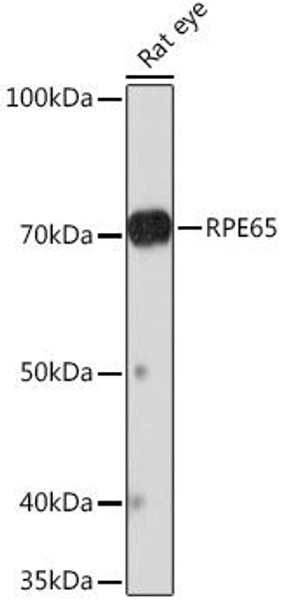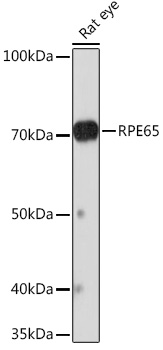Anti-RPE65 Antibody (CAB9615)
- SKU:
- CAB9615
- Product type:
- Antibody
- Reactivity:
- Human
- Mouse
- Rat
- Host Species:
- Rabbit
- Isotype:
- IgG
- Antibody Type:
- Monoclonal Antibody
- Research Area:
- Signal Transduction
Description
| Antibody Name: | Anti-RPE65 Antibody |
| Antibody SKU: | CAB9615 |
| Antibody Size: | 20uL, 50uL, 100uL |
| Application: | WB IHC IF |
| Reactivity: | Human, Mouse, Rat |
| Host Species: | Rabbit |
| Immunogen: | A synthesized peptide derived from human RPE65 |
| Application: | WB IHC IF |
| Recommended Dilution: | WB 1:500 - 1:2000 IHC 1:50 - 1:200 IF 1:50 - 1:200 |
| Reactivity: | Human, Mouse, Rat |
| Positive Samples: | Rat eye |
| Immunogen: | A synthesized peptide derived from human RPE65 |
| Purification Method: | Affinity purification |
| Storage Buffer: | Store at -20°C. Avoid freeze / thaw cycles. Buffer: PBS with 0.02% sodium azide, 0.05% BSA, 50% glycerol, pH7.3. |
| Isotype: | IgG |
| Sequence: | Email for sequence |
| Gene ID: | 6121 |
| Uniprot: | Q16518 |
| Cellular Location: | |
| Calculated MW: | 61kDa |
| Observed MW: | 68KDa |
| Synonyms: | BCO3, LCA2, RP20, mRPE65, rd12, sRPE65 |
| Background: | This gene encodes a protein which is located in the retinal pigment epithelium and is involved in the production of 11-cis retinal and in visual pigment regeneration. There are two forms of this protein, a soluble form called sRPE65, and a palmitoylated, membrane-bound form known as mRPE65. mRPE65 serves as the palmitoyl donor for lecithin retinol acyl transferase (LRAT), the enzyme that catalyzes the vitamin A to all trans retinol step of the chromophore regeneration process. Both mRPE65 and sRPE65 also serve as regulatory proteins, with the ratio and concentrations of these molecules playing a role in the inhibition of 11-cis retinal synthesis. Mutations in this gene have been associated with Leber congenital amaurosis type 2 (LCA2) and retinitis pigmentosa. [provided by RefSeq, Jul 2008] |
| UniProt Protein Function: | RPE65: Plays important roles in the production of 11-cis retinal and in visual pigment regeneration. The soluble form binds vitamin A (all-trans-retinol), making it available for LRAT processing to all-trans-retinyl ester. The membrane form, palmitoylated by LRAT, binds all-trans-retinyl esters, making them available for IMH (isomerohydrolase) processing to all-cis- retinol. The soluble form is regenerated by transferring its palmitoyl groups onto 11-cis-retinol, a reaction catalyzed by LRAT. The enzymatic activity is linearly dependent of the expression levels and membrane association. Defects in RPE65 are the cause of Leber congenital amaurosis type 2 (LCA2). LCA designates a clinically and genetically heterogeneous group of childhood retinal degenerations, generally inherited in an autosomal recessive manner. Affected infants have little or no retinal photoreceptor function as tested by electroretinography. LCA represents the most common genetic cause of congenital visual impairment in infants and children. Defects in RPE65 are the cause of retinitis pigmentosa type 20 (RP20). RP leads to degeneration of retinal photoreceptor cells. Patients typically have night vision blindness and loss of midperipheral visual field. As their condition progresses, they lose their far peripheral visual field and eventually central vision as well. Defects in RPE65 are a cause of autosomal dominant retinitis pigmentosa with choroidal involvement (PubMed:21654732). Affected individuals show reduction of central vision, constriction of visual fields, night blindness and chorioretinal atrophy. Belongs to the carotenoid oxygenase family. |
| UniProt Protein Details: | Protein type:Cofactor and Vitamin Metabolism - retinol; EC 3.1.1.64 Chromosomal Location of Human Ortholog: 1p31 Cellular Component: endoplasmic reticulum; membrane; plasma membrane Molecular Function:metal ion binding; phosphatidylcholine binding; phosphatidylserine binding; retinal isomerase activity Biological Process: circadian rhythm; detection of light stimulus involved in visual perception; insulin receptor signaling pathway; phototransduction, visible light; regulation of rhodopsin gene expression; retina morphogenesis in camera-type eye; retinal homeostasis; retinal metabolic process; retinoid metabolic process; retinol metabolic process; visual perception; vitamin A metabolic process Disease: Leber Congenital Amaurosis 2; Retinitis Pigmentosa 20 |
| NCBI Summary: | This gene encodes a protein which is located in the retinal pigment epithelium and is involved in the production of 11-cis retinal and in visual pigment regeneration. There are two forms of this protein, a soluble form called sRPE65, and a palmitoylated, membrane-bound form known as mRPE65. mRPE65 serves as the palmitoyl donor for lecithin retinol acyl transferase (LRAT), the enzyme that catalyzes the vitamin A to all trans retinol step of the chromophore regeneration process. Both mRPE65 and sRPE65 also serve as regulatory proteins, with the ratio and concentrations of these molecules playing a role in the inhibition of 11-cis retinal synthesis. Mutations in this gene have been associated with Leber congenital amaurosis type 2 (LCA2) and retinitis pigmentosa. [provided by RefSeq, Jul 2008] |
| UniProt Code: | Q16518 |
| NCBI GenInfo Identifier: | 4506591 |
| NCBI Gene ID: | 6121 |
| NCBI Accession: | NP_000320.1 |
| UniProt Secondary Accession: | Q16518,Q5T9U3, A8K1L0, |
| UniProt Related Accession: | Q16518 |
| Molecular Weight: | 60,948 Da |
| NCBI Full Name: | retinoid isomerohydrolase |
| NCBI Synonym Full Names: | retinal pigment epithelium-specific protein 65kDa |
| NCBI Official Symbol: | RPE65 |
| NCBI Official Synonym Symbols: | BCO3; LCA2; RP20; rd12; mRPE65; sRPE65 |
| NCBI Protein Information: | retinoid isomerohydrolase |
| UniProt Protein Name: | Retinoid isomerohydrolase |
| UniProt Synonym Protein Names: | All-trans-retinyl-palmitate hydrolase; Retinal pigment epithelium-specific 65 kDa protein; Retinol isomerase |
| Protein Family: | Retinoid isomerohydrolase |
| UniProt Gene Name: | RPE65 |
| UniProt Entry Name: | RPE65_HUMAN |







